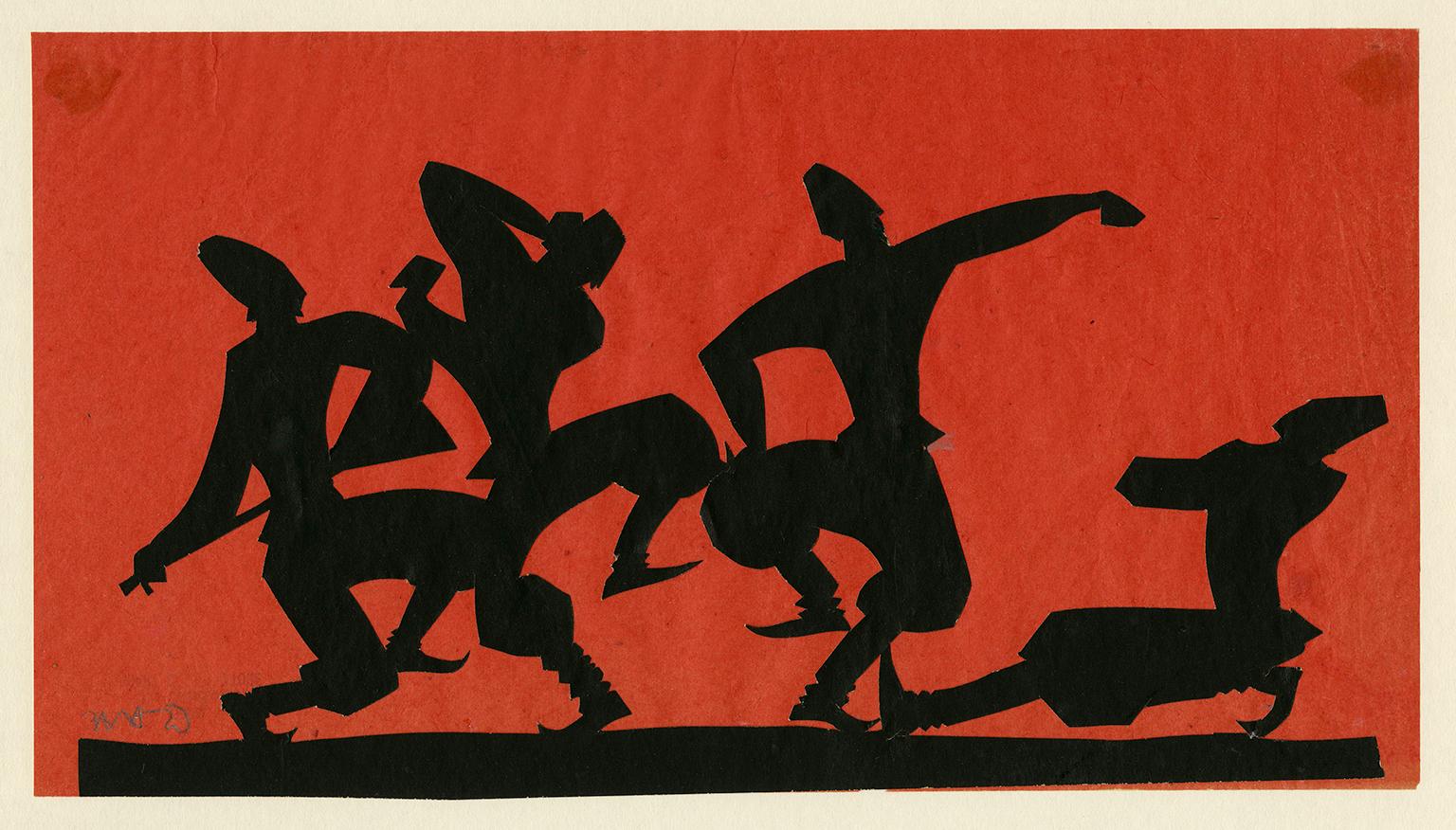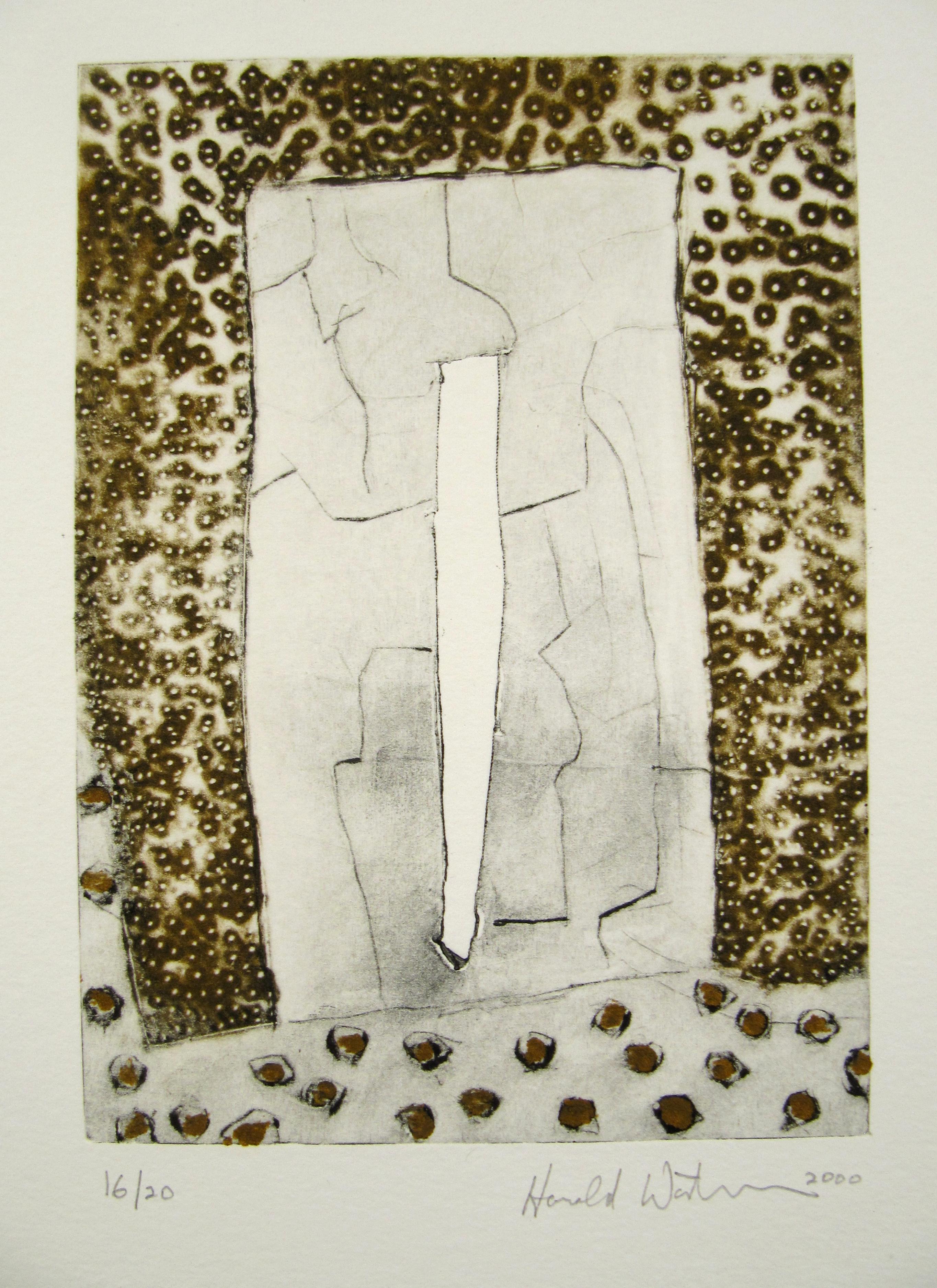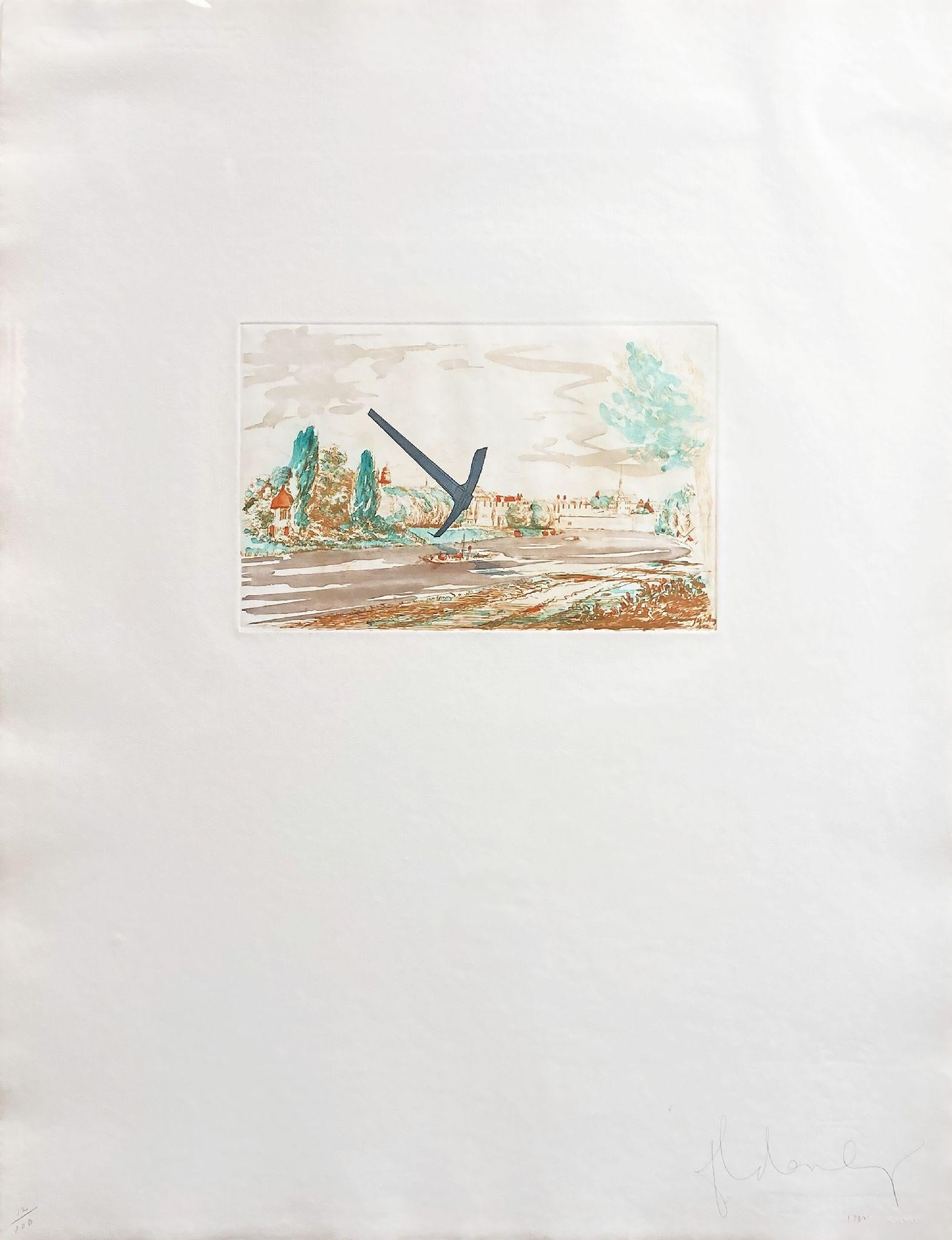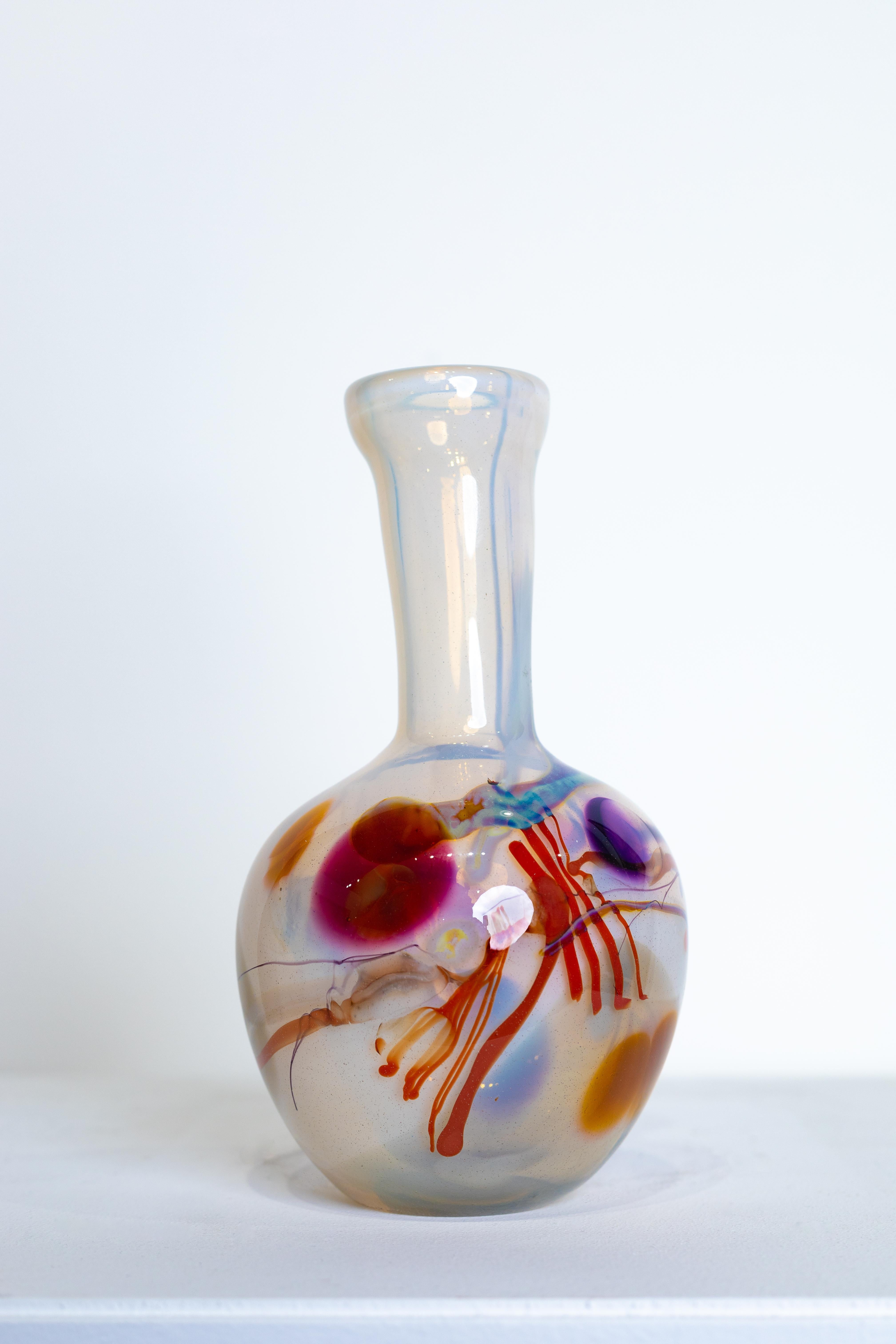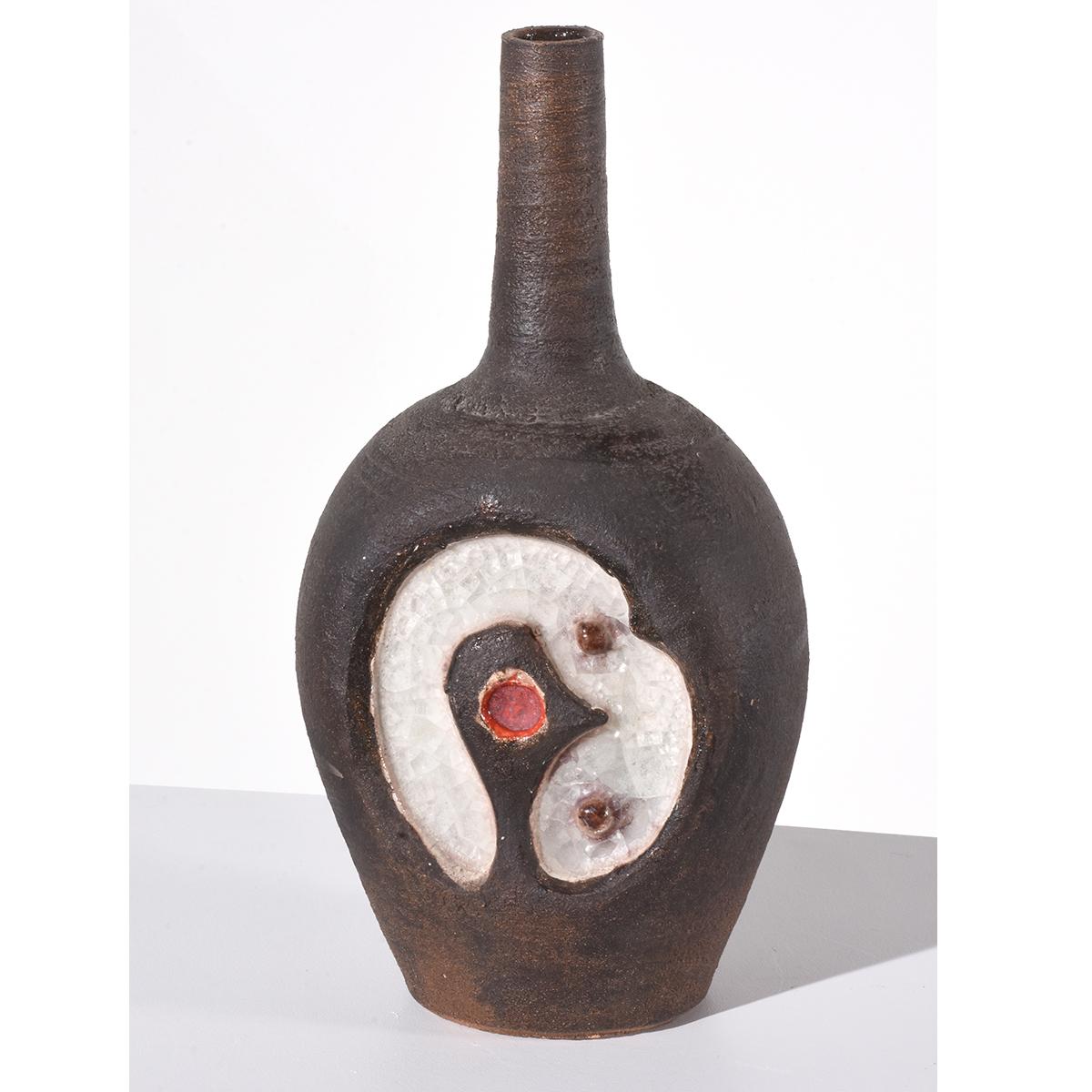Items Similar to Car Service, cut paper collage, urban landscape, hard edge, bold graphic, text
Want more images or videos?
Request additional images or videos from the seller
1 of 5
Philomena MaranoCar Service, cut paper collage, urban landscape, hard edge, bold graphic, text2017
2017
About the Item
CAR SERVICE
Hand cut paper on heavy weight gessoed watercolor paper, framed in flat gray painted wood & plexi. Ms. Marano is a daughter of Brooklyn. She holds a BFA from Pratt Institute, is an intimate of the visual poetry of Coney Island, created the winning poster for the first Spirit of Brooklyn poster competition, and is a master of papier collé, the elegant cut paper technique she learned as a studio assistant to preeminent artist Robert Indiana. Her series, FLAT FIX elevates the often un-noticed gritty tire shops she has discovered during her walks through a bleak industrial area to her Brooklyn studio. "They suddenly stood out like little carnivals, red and yellow cones and signs, tumbledown but full of interesting graphics. I rendered them with as few forms as possible leaving the viewer's eyes to complete the scene." There are 12 images in the FLAT FIX series.
Philomena Marano has spent decades “penetrat[ing] the soul of Coney Island to reveal its twin promises of candy-colored paradise and garishly ornate nightmare,” as Ann Aptaker describes, through the prints and cut-paper collage in her “American Dream-land” series (1979-). These colorful, graphic style works evoke the energy and amusement of Coney Island through depictions of the rides, the boardwalk, clowns, and food vendors. Many are large-scale papier collé installations, a technique Marano learned from Robert Indiana in whose studio she formerly assisted. In conjunction with “American Dream Land,” in 1981 Marano and Richard Eagan co-founded the Coney Island Hysterical Society, which undertakes projects such as restoring old rides in response to the alarming rate at which they were shutting down in the fabled amusement park of their childhood.
Ms. Marano is a daughter of Brooklyn. She holds a BFA from Pratt Institute, is an intimate of the visual poetry of Coney Island, created the winning poster for the first Spirit of Brooklyn poster competition, and is a master of papier collé, the elegant cut paper technique she learned as a studio assistant to preeminent artist Robert Indiana.
Marano’s acclaimed series, “American- Dream-Land,” a decades-spanning project of papier collé originals and limited edition prints, penetrates the soul of Coney Island to reveal its twin promises of candy-colored paradise and gritty raw excitement. Her ornate compositions are cut out of “color-aid” paper - a type of paper coated with vibrant screen printers ink, the same paper which Romare Bearden frequently incorporated into his collages.
Marano’s work has been exhibited by Tabla Rasa Gallery, ACA Galleries, by Prince Street Gallery, Smart Clothes Gallery, the Municipal Art Society, the Museum of the City of New York, the Bronx Museum of the Arts, and the Coney Island Museum among others in the New York area and at the George Krevsky Gallery in San Francisco and are also represented in private, corporate and museum collections including the Brooklyn Museum.
“American Dream-Land” and Marano’s work as a co-founder (with artist Richard Eagan) of the Coney Island Hysterical Society were featured in Charles Denson’s award-winning book “Coney Island Lost and Found” (Ten Speed Press, Berkeley/Toronto, 2002). Additional publications featuring Marano and “American Dream-Land” include Amusing the Zillion, 24/7 Magazine, the New York Times, the Daily News and others.
Her current work expands into the larger city, exposing elements of urban life: the underappreciated grace of an out-of-the-way tire shop; the disquieting lure of an exit sign at night. In addition to creating papier collé images for this examination of the city’s overlooked beauty, she is also working on a cut-paper animation, “Take Me There,” a fantasy inspired by both her early train rides to Coney Island and a proposal for the Franklin Avenue subway. The ”Take Me There” trailer is posted for viewing on You Tube.
Born in Brooklyn, NY
Lives & works in Brooklyn, NY
and in Sarasota, Florida
- Creator:Philomena Marano (1952, American)
- Creation Year:2017
- Dimensions:Height: 15.75 in (40.01 cm)Width: 15.75 in (40.01 cm)Depth: 1.25 in (3.18 cm)
- Medium:
- Movement & Style:
- Period:
- Condition:
- Gallery Location:Brooklyn, NY
- Reference Number:1stDibs: LU133916938752
Philomena Marano
Philomena was raised in Brooklyn, just a stone’s throw from America’s most famous amusement park, Coney Island. She is most known for cut paper collage and limited edition prints in her acclaimed collection, “American-Dream-Land” in which she depicts both personal and universal themes in the rides, signs and attractions of her childhood playground. In 2017 , a move to Florida shifted her attention to the circus thrill shows of Sarasota. The precision, exhilaration and wonder embedded in the spectacle of these performances were a definite reminder of the fun and danger of the wondrous mechanical constructions in Coney Island; a continuity of earlier sensibilities. She acquired and honed her cut paper skills while working as an assistant to preeminent artist Robert Indiana in his New York studio on a prodigious cut paper project rendering set and costume designs for “The Mother of Us All”, Santa Fe Opera. In 2020, she was invited to give artist talks at the MFA St. Pete’s, FL. on her experiences working on the project in an exhibition titled: Art of the Stage: Picasso to Hockney where many of Indiana’s stage designs from “Mother” were displayed. Marano is co-founder of the Coney Island Hysterical Society, earned a BFA from Pratt Institute , and has been included in numerous galleries including Tabla Rasa Gallery, Brooklyn ,NY, ACA Gallery, NY, New York, Deutsche Bank, NY, New York, The DeLand Museum of Art, FL., Ringling College of Art & Design, Sarasota, FL., and the Art Center Sarasota.
Her work is featured in Charles Denson’s book, “Coney Island, Lost and Found,”
Ten Speed Press, 2002, SRQ magazine, 2021 , Luxe Interior + Design, 2021, Between 2Two Shores, a UK based Literary & Art publication, 2021, among others
and is in many private and corporate collections including the Brooklyn Museum.
About the Seller
5.0
Vetted Seller
These experienced sellers undergo a comprehensive evaluation by our team of in-house experts.
Established in 2005
1stDibs seller since 2020
84 sales on 1stDibs
Typical response time: 2 hours
- ShippingRetrieving quote...Ships From: Sarasota , FL
- Return PolicyA return for this item may be initiated within 7 days of delivery.
More From This SellerView All
- PLAY FASCINATION 2, colorful mixed media, textBy Philomena MaranoLocated in Brooklyn, NYAcrylic on canvas paper, mounted on masonite with black enamel painted frame.Category
1990s American Modern Mixed Media
MaterialsEnamel
- Alarm, Rims, Tint, Urban scene, city, hard edge, graphic, industrial, tiresBy Philomena MaranoLocated in Brooklyn, NYAlarms, Rims,Tint is part of Marano's FLAT FIX series- Hand cut paper on heavy weight gessoed watercolor paper, framed in flat gray painted wood & plexi. Ms. Marano is a daughter of Brooklyn. She holds a BFA from Pratt Institute, is an intimate of the visual poetry of Coney Island, created the winning poster for the first Spirit of Brooklyn poster...Category
2010s American Modern Mixed Media
MaterialsPaper, Watercolor
- Luna's Tire Shop, Urban, cut paper collage, playful, industrial, tires, framedBy Philomena MaranoLocated in Brooklyn, NYLUNA'S TIRE SHOP : Hand cut paper on heavy weight gessoed watercolor paper, framed in flat gray painted wood & plexi. Ms. Marano is a daughter of Brooklyn...Category
2010s American Modern Drawings and Watercolor Paintings
MaterialsPaper, Archival Paper
- FLAT, cut paper collage urban New York street culture industrialBy Philomena MaranoLocated in Brooklyn, NY"FLAT" Hand cut paper on heavy weight gessoed watercolor paper Ms. Marano is a daughter of Brooklyn. She holds a BFA from Pratt Institute, is an intimate of the visual poetry of Coney Island, created the winning poster for the first Spirit of Brooklyn poster...Category
2010s American Modern Drawings and Watercolor Paintings
MaterialsPaper, Archival Paper
- Lacy Grey, semi nude mixed media muted tones lace charcoalBy Audrey AnastasiLocated in Brooklyn, NYCharcoal, pastel lace Audrey Anastasi states: "The paper doll series was created first in the presence of a live model, working quickly, in charcoal an...Category
2010s American Modern Mixed Media
MaterialsCharcoal, Pastel, Fabric, Archival Paper
- Book of Remembrance, female figure, gold tones, horses & Van Gogh referencesBy Audrey AnastasiLocated in Brooklyn, NYThese collages were created first in the presence of a model, working quickly, in charcoal and pastel, and again, later, alone, furiously tearing and pasting images from magazines, v...Category
2010s American Modern Mixed Media
MaterialsCharcoal, Mixed Media, Archival Paper
You May Also Like
- Cossack DancersBy Wilhelm Hunt DiederichLocated in Myrtle Beach, SCWilhelm Hunt Diederich, 'Cossack Dancers', cut paper silhouette, c. 1920. Signed 'WHD' in pencil, lower left image. Black, wove, cut paper, laid on ...Category
1920s American Modern More Art
MaterialsLaid Paper
- Harold Wortsmann (USA, 1950) - Limited Colored Engraving 16/20 - Time HoleBy Harold WortsmanLocated in Meinisberg, CHHarold Wortsmann (American, *1950) Time Hole • Colored Engraving • Sheet ca. 28.5 x 25.5 cm • Signed, dated 2000 & limited 16/20 • Blindstamp bottom left corner • Inscribed v...Category
Early 2000s American Modern Abstract Prints
MaterialsPaper, Engraving
- Pickaxe (Spitzhacke) Superimposed on a Drawing of the Site by E.L. GrimmBy Claes OldenburgLocated in Missouri, MOPickaxe (Spitzhacke) Superimposed on a Drawing of the Site by E.L. Grimm, 1982 By Claes Oldenburg (Swedish, American, 1929-2022) Unframed: 26" x 20" Framed: 28.75" x 22.75" Signed and Dated Lower Right Whimsical sculpture of pop culture objects, many of them large and out-of-doors, is the signature work of Swedish-born Claes Oldenburg who became one of America's leading Pop Artists. He was born in Stockholm, Sweden. His father was a diplomat, and during Claes' childhood moved his family from Stockholm to a variety of locations including Chicago where the father was general consul of Sweden and where Oldenburg spent most of his childhood. He attended the Latin School of Chicago, and then Yale University where he studied literature and art history, graduating in 1950, the same year Claes became an American citizen. Returning to Chicago, he enrolled at the Art Institute of Chicago from 1952 to 1954 and also worked as a reporter at the City News Bureau. He opened his own studio, and in 1953, some of his satirical drawings were included in his first group show at the Club St. Elmo, Chicago. He also painted at the Oxbow School of Painting in Michigan. In 1956, he moved to New York where he drew and painted while working as a clerk in the art libraries of Cooper-Union Museum for the Arts of Decoration. Selling his first artworks during this time, he earned 25 dollars for five pieces. Oldenburg became friends with numerous artists including Jim Dine, Red Grooms and Allan Kaprow, who with his "Happenings" was especially influential on Oldenburg's interest in environmental art. Another growing interest was soft sculpture, and in 1957, he created a piece later titled Sausage, a free-hanging woman's stocking stuffed with newspaper. In 1959, he had his first one-man show, held at the Judson Gallery at Washington Square. He exhibited wood and newspaper sculpture and painted papier-mache objects. Some viewers of the exhibit commented how refreshing Oldenburg's pieces were in contrast to the Abstract Expressionism, a style which much dominated the art world. During this time, he was influenced by the whimsical work of French artist, Bernard Buffet, and he experimented with materials and images of the junk-filled streets of New York. In 1960, Oldenburg created his first Pop-Art Environments and Happenings in a mock store full of plaster objects. He also did Performances with a cast of colleagues including artists Lucas Samaras, Tom Wesselman, Carolee Schneemann, Oyvind Fahlstrom and Richard Artschwager, dealer Annina Nosei, critic Barbara Rose, and screenwriter Rudy Wurlitzer. His first wife (1960-1970) Pat Muschinski, who sewed many of his early soft sculptures, was a constant performer in his Happenings. This brash, often humorous, approach to art was at great odds with the prevailing sensibility that, by its nature, art dealt with "profound" expressions or ideas. In December 1961, he rented a store on Manhattan's Lower East Side to house "The Store," a month-long installation he had first presented at the Martha Jackson Gallery in New York. This installation was stocked with sculptures roughly in the form of consumer goods. Oldenburg moved to Los Angeles in 1963 "because it was the most opposite thing to New York I could think of". That same year, he conceived AUT OBO DYS, performed in the parking lot of the American Institute of Aeronautics and Astronautics in December 1963. In 1965 he turned his attention to drawings and projects for imaginary outdoor monuments. Initially these monuments took the form of small collages such as a crayon image of a fat, fuzzy teddy bear looming over the grassy fields of New York's Central Park (1965) and Lipsticks in Piccadilly Circus, London (1966). Oldenburg realized his first outdoor public monument in 1967; Placid Civic Monument took the form of a Conceptual performance/action behind the Metropolitan Museum of Art, New York, with a crew of gravediggers digging a 6-by-3-foot rectangular hole in the ground. Many of Oldenburg's large-scale sculptures of mundane objects elicited public ridicule before being embraced as whimsical, insightful, and fun additions to public outdoor art. From the early 1970s Oldenburg concentrated almost exclusively on public commissions. Between 1969 and 1977 Oldenburg had been in a relationship with Hannah Wilke, feminist artist, but in 1977 he married Coosje van Bruggen, a Dutch-American writer and art historian who became collaborator with him on his artwork. He had met her in 1970, when she curated an exhibition for him at the Stedelijk Museum in Amsterdam. Their first collaboration came when Oldenburg was commissioned to rework Trowel I, a 1971 sculpture of an oversize garden tool, for the grounds of the Kröller-Müller Museum in Otterlo, the Netherlands. Oldenburg has officially signed all the work he has done since 1981 with both his own name and van Bruggen's. In 1988, the two created the iconic Spoonbridge and Cherry sculpture for the Walker Art Center in Minneapolis, Minnesota that remains a staple of the Minneapolis Sculpture Garden as well as a classic image of the city. Typewriter Eraser...Category
20th Century American Modern Mixed Media
MaterialsEtching, Aquatint, Photogravure
- Herb Babcock "Glass Vase" Blown Glass White & Blue Background Red SplashesLocated in Detroit, MISALE ONE WEEK ONLY "Blown Glass" vase is a light beautiful wisp of blown glass infused with a milky white and blue fog of color and bold splashes of red. The vase has a long elegant neck and round body. Herb Babcock known as a Michigan Glass Artist began as a metal sculptor. He studied glass blowing in 1969 and created a series of Glass Image Vessels in 1974. Eventually he began to combine metal and glass in sculpture. The Pillared Series, which includes glass, steel and stone, began in 1989. Herb received both his BFA and his MFA in Sculpture: his bachelor’s degree from the Cleveland Institute of Art and his master’s from the Cranbrook Academy of Art Bloomfield Hills, Michigan. Cranbrook was designed by architect and faculty member, Eliel Saarinen who collaborated with Charles and Ray Eames on chair and furniture design. Numerous creative artists who are alumni of Cranbrook include: Harry Bertoia, Florence Knoll, Jack Lenor Larsen, Donald Lipski, Duane Hanson, Nick Cave, Hani Rashid, George Nelson, Urban Jupena (Nationally recognized fiber artist), Artis Lane (the first African-American artist to have her sculpture, "Sojourner Truth," commissioned for the Emancipation Hall in the Capital Visitor Center in Washington DC), Cory Puhlman (televised Pastry Chef extraordinaire), Thom O’Connor (Lithographs), Paul Evans (Brutalist-inspired sculpted metal furnishings), Eugene Caples (small bronze images/abstract), and Morris Brose...Category
1970s American Modern More Art
MaterialsGlass
- Aldo Londi Vase Abstract "Glass Fused Ceramic Vase"Located in Detroit, MISALE ONE WEEK ONLY "Glass Fused Ceramic Vase" is vintage Mid-Century Modern. This handsome vase has an elongated neck with a white glass-fused inlay porti...Category
Mid-20th Century American Modern More Art
MaterialsCeramic, Glass
- John Glick Plum Street Pottery Reduction Fired Shino Glaze Cup Published in BookLocated in Detroit, MI“Untitled” ceramic, is an example of the kind of work by which John Glick became so famous. He was seduced by the effects of the reduction kiln, which decreased the levels of oxygen during firing, inducing the flame to pull oxygen out of the clay and glazes changing the colors of the glazes depending on their iron and copper content. In this way he achieved the rich gradients of ochre and umber and variations in stippling and opacity. This piece is signed on the bottom and can be found on page 92, plate #125 in “John Glick: A Legacy in Clay.” John was an American Abstract Expressionist ceramicist born in Detroit, MI. Though open to artistic experimentation, Glick was most influenced by the styles and aesthetics of Asian pottery—an inspiration that shows in his use of decorative patterns and glaze choices. He has said that he is attracted to simplicity, as well as complexity: my work continually reflects my re-examination that these two poles can coexist… or not, in a given series. Glick also took influences from master potters of Japan, notably Shoji Hamada and Kanjrio Kawai, blending their gestural embellishments of simple forms with attitudes of Abstract Expressionism. He was particularly drown to the work of Helen Frankenthaler whose soak-stain style resonated with Glick’s multi-layered glaze surfaces, which juxtaposed veils of atmospheric color with gestural marks and pattern. He spent countless hours developing and making his own tools in order to achieve previously unseen results in his work with clay and glaze. Glick’s “Plum Tree Pottery...Category
1990s American Modern More Art
MaterialsStoneware, Glaze
